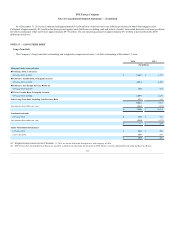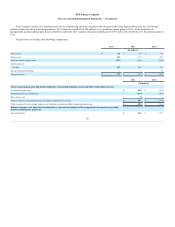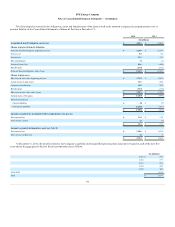DTE Energy 2014 Annual Report Download - page 93
Download and view the complete annual report
Please find page 93 of the 2014 DTE Energy annual report below. You can navigate through the pages in the report by either clicking on the pages listed below, or by using the keyword search tool below to find specific information within the annual report.
The Company received an NOV from the Allegheny County (PA) Health Department pertaining to excessive opacity readings from fugitive sources
(mainly pushing emissions) in excess of its opacity standards for the Pennsylvania coke battery facility. Fugitive sources at the plant are in full compliance
with the applicable Federal Opacity Standards. In February 2014, the Company received from the Group Against Smog & Pollution (GASP) a 60 day Notice
of Intent to sue letter under the Federal Clean Air Act and/or Article XXI of the Allegheny County (PA) Health Department's Rules and Regulations. GASP
alleged in the letter that the Company's coke battery facility in Pennsylvania was in violation of visible emissions limits from charging activities, door leaks,
the combustion stack and pushing operations and hydrogen sulfide emission limits on flared, mixed or combusted coke oven gas. To resolve these issues, the
Company agreed to a Consent Order and Agreement with Allegheny County pursuant to which the Company paid a fine of $300,000 and will spend
$300,000 for a supplemental environmental project to enhance particulate collection efficiency from the coke battery's quench tower. Notwithstanding the
agreement reached with the County, GASP proceeded with the filing of their complaint in May 2014. The Company believes that the GASP suit is without
merit and filed a motion to dismiss in July 2014.
Other
In 2010, the EPA finalized a new 1-hour sulfur dioxide ambient air quality standard that requires states to submit plans for non-attainment areas to be in
compliance by 2017. Michigan's non-attainment area includes DTE Energy facilities in southwest Detroit and areas of Wayne County. Preliminary modeling
runs by the MDEQ suggest that emission reductions may be required by significant sources of sulfur dioxide emissions in these areas, including DTE Electric
power plants and our Michigan coke battery. The state implementation plan process is in the information gathering stage, and DTE Energy is unable to
estimate any required emissions reductions at this time.
Property Insurance
DTE Electric maintains property insurance policies specifically for the Fermi 2 plant. These policies cover such items as replacement power and
property damage. NEIL is the primary supplier of the insurance policies.
DTE Electric maintains a policy for extra expenses, including replacement power costs necessitated by Fermi 2’s unavailability due to an insured event.
This policy has a 12-week waiting period and provides an aggregate $490 million of coverage over a three-year period.
DTE Electric has $1.5 billion in primary coverage and $1.25 billion of excess coverage for stabilization, decontamination, debris removal, repair and/or
replacement of property and decommissioning. The combined coverage limit for total property damage is $2.75 billion, subject to a $1 million deductible.
The total limit for property damage for non-nuclear events is $2 billion and an aggregate of $328 million of coverage for extra expenses over a two-year
period.
On January 13, 2015, the Terrorism Risk Insurance Program Reauthorization Act of 2015 was signed, extending TRIA through December 31, 2020. For
multiple terrorism losses caused by acts of terrorism not covered under the TRIA occurring within one year after the first loss from terrorism, the NEIL policies
would make available to all insured entities up to $3.2 billion, plus any amounts recovered from reinsurance, government indemnity, or other sources to
cover losses.
Under NEIL policies, DTE Electric could be liable for maximum assessments of up to approximately $35 million per event if the loss associated with
any one event at any nuclear plant should exceed the accumulated funds available to NEIL.
Public Liability Insurance
As required by federal law, DTE Electric maintains $375 million of public liability insurance for a nuclear incident. For liabilities arising from a
terrorist act outside the scope of TRIA, the policy is subject to one industry aggregate limit of $300 million. Further, under the Price-Anderson Amendments
Act of 2005, deferred premium charges up to $127 million could be levied against each licensed nuclear facility, but not more than $19 million per year per
facility. Thus, deferred premium charges could be levied against all owners of licensed nuclear facilities in the event of a nuclear incident at any of these
facilities.
90
























